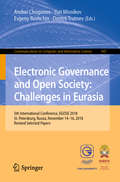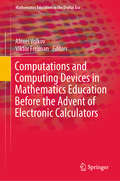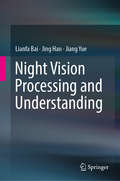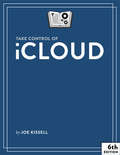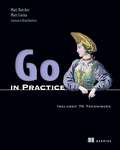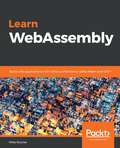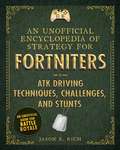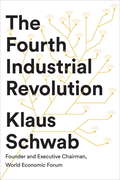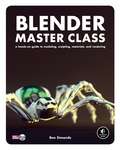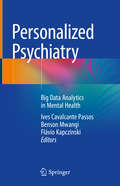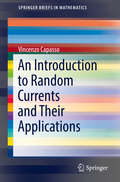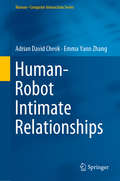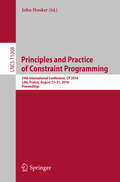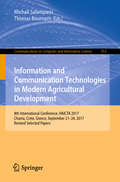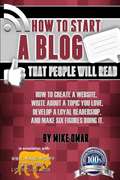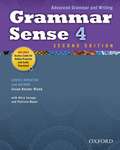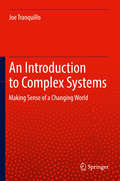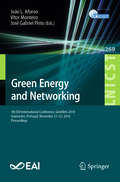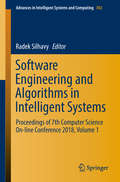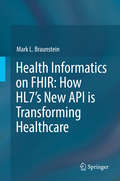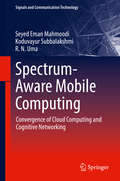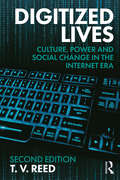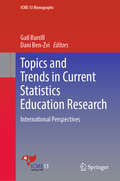- Table View
- List View
Electronic Governance and Open Society: 5th International Conference, EGOSE 2018, St. Petersburg, Russia, November 14-16, 2018, Revised Selected Papers (Communications in Computer and Information Science #947)
by Andrei Chugunov Yuri Misnikov Evgeny Roshchin Dmitrii TrutnevThis book constitutes the refereed proceedings of the 5th Conference on AElectronic Governance and Open Society: Challenges in Eurasia, EGOSE 2018, held in St. Petersburg, Russia, in November 2018. The 36 revised full papers were carefully reviewed and selected from 98 submissions. The papers are organized in topical sections on smart city infrastructure, policy; digital privacy, rights,security;data science, machine learning, algorithms, computational linguistics; digital public administration, economy, policy; digital services, values, inclusion; digital democracy, participation, security, communities, social media, activism; social media discourse analysis; digital data, policy modeling; digital government, administration, communication.
Computations and Computing Devices in Mathematics Education Before the Advent of Electronic Calculators (Mathematics Education in the Digital Era #11)
by Alexei Volkov Viktor FreimanThis volume traces back the history of interaction between the “computational” or “algorithmic” aspects of elementary mathematics and mathematics education throughout ages. More specifically, the examples of mathematical practices analyzed by the historians of mathematics and mathematics education who authored the chapters in the present collection show that the development (and, in some cases, decline) of counting devices and related computational practices needs to be considered within a particular context to which they arguably belonged, namely, the context of mathematics instruction; in their contributions the authors also explore the role that the instruments played in formation of didactical approaches in various mathematical traditions, stretching from Ancient Mesopotamia to the 20th century Europe and North America.
Night Vision Processing and Understanding
by Lianfa Bai Jing Han Jiang YueThis book systematically analyses the latest insights into night vision imaging processing and perceptual understanding as well as related theories and methods. The algorithm model and hardware system provided can be used as the reference basis for the general design, algorithm design and hardware design of photoelectric systems. Focusing on the differences in the imaging environment, target characteristics, and imaging methods, this book discusses multi-spectral and video data, and investigates a variety of information mining and perceptual understanding algorithms. It also assesses different processing methods for multiple types of scenes and targets.Taking into account the needs of scientists and technicians engaged in night vision optoelectronic imaging detection research, the book incorporates the latest international technical methods. The content fully reflects the technical significance and dynamics of the new field of night vision. The eight chapters cover topics including multispectral imaging, Hadamard transform spectrometry; dimensionality reduction, data mining, data analysis, feature classification, feature learning; computer vision, image understanding, target recognition, object detection and colorization algorithms, which reflect the main areas of research in artificial intelligence in night vision.The book enables readers to grasp the novelty and practicality of the field and to develop their ability to connect theory with real-world applications. It also provides the necessary foundation to allow them to conduct research in the field and adapt to new technological developments in the future.
Take Control of iCloud (6.0)
by Joe KisselliCloud is Apple’s suite of internet services. This book helps you make sense of iCloud, configure it for your needs, and choose the best ways of using each feature.
Go in Practice
by Matt Butcher Matt FarinaThis practical handbook builds on the foundational concepts of the Go language and introduces specific strategies you can use in your day-to-day applications. <P><P>You'll learn techniques for building web services, using Go in the cloud, testing and debugging, routing, network applications, and much more. <P><P>After finishing this book, you will be ready to build sophisticated cloud-native Go applications.
Learn WebAssembly: Build web applications with native performance using Wasm and C/C++
by Mike RourkeIn the first definitive guide on WebAssembly, you’ll learn how you can wield this new technology to break through the current barriers of web development and build an entirely new class of performant applications .Key FeaturesGenerate WebAssembly modules from C and C++ using Emscripten and interact with these modules in the browser Learn how to use WebAssembly outside of the browser and load modules using Node.js Build a high-performance application using C and WebAssembly and port an existing C++ game to WebAssembly using Emscripten Book DescriptionWebAssembly is a brand-new technology that represents a paradigm shift in web development. This book aims to teaches programmers how to leverage this technology to write high- performance applications that run in the browser. This book will introduces you to the powerful WebAssembly concepts of WebAssembly that willto help you write lean and powerful web applications with native performance.You will start with the evolution of web programming, the state of things today, and what can be done with the advent and release of WebAssembly. We take a look at the journey from JavaScript to asm.js to WebAssembly. We then move on to analyzinge the anatomy of a WebAssembly module and the relationship between the binary and text formats, along with the corresponding JavaScript API.Further on, weyou'll implement all the techniques you've learned by to building a high-performance application using C and WebAssembly, and then port an existing game written in C++ to WebAssembly using Emscripten.By the end of this book, you would will be well-equipped to create high-performance applications and games for the web using WebAssembly.What you will learnLearn how WebAssembly came to be and its associated elements (text format, module, and JavaScript API)Create, load, and debug a WebAssembly module (editor and compiler/toolchain)Build a high-performance application using C and WebAssemblyExtend WebAssembly’s feature set using Emscripten by porting a game written in C++Explore upcoming features of WebAssembly, Node.js integration, and alternative compilation methodsWho this book is forIf you are a web developer or C/C++ programmer keen to leverage the powerful technology of WebAssembly to build high-performance web applications, then this book is for you.
An Unofficial Encyclopedia of Strategy for Fortniters: ATK Driving Techniques, Challenges, and Stunts
by Jason R. RichMake the most of your All Terrain Kart in Fortnite Battle Royale! An Unofficial Encyclopedia of Strategy for Fortniters: ATK Driving Techniques, Challenges, and Stunts is a comprehensive driving manual, teaching you how to find and effectively drive or ride an ATK during a match. <P><P>From basic driving techniques and exploration of the island to advanced ways to utilize an ATK offensively and defensively during any match, this guide runs the gamut of ATK optimization. By reading this double-length guide, you’ll learn all about Fortnite Battle Royale and how to survive in a wide range of situations, using the weapons, ammo, loot items, and resources available to them. Master the terrain and use it to your tactical advantage during high-intensity firefights and all-out battles! <P><P>Take an “A to Z” tour of the mysterious island and learn what to expect at each labeled and unlabeled point of interest Discover strategies for surviving in those areas once they arrive Survive and win battles in different terrain, including cities, farms, factories, underground tunnels, junkyards, open valleys, water, etc. Travel greater distances around the island armed with better strategy
The Fourth Industrial Revolution: A Guide To Building A Better World
by Klaus SchwabWorld-renowned economist Klaus Schwab, Founder and Executive Chairman of the World Economic Forum, explains that we have an opportunity to shape the fourth industrial revolution, which will fundamentally alter how we live and work. Schwab argues that this revolution is different in scale, scope and complexity from any that have come before. Characterized by a range of new technologies that are fusing the physical, digital and biological worlds, the developments are affecting all disciplines, economies, industries and governments, and even challenging ideas about what it means to be human. Artificial intelligence is already all around us, from supercomputers, drones and virtual assistants to 3D printing, DNA sequencing, smart thermostats, wearable sensors and microchips smaller than a grain of sand. But this is just the beginning: nanomaterials 200 times stronger than steel and a million times thinner than a strand of hair and the first transplant of a 3D printed liver are already in development. Imagine "smart factories" in which global systems of manufacturing are coordinated virtually, or implantable mobile phones made of biosynthetic materials. The fourth industrial revolution, says Schwab, is more significant, and its ramifications more profound, than in any prior period of human history. He outlines the key technologies driving this revolution and discusses the major impacts expected on government, business, civil society and individuals. Schwab also offers bold ideas on how to harness these changes and shape a better future--one in which technology empowers people rather than replaces them; progress serves society rather than disrupts it; and in which innovators respect moral and ethical boundaries rather than cross them. We all have the opportunity to contribute to developing new frameworks that advance progress.From the Hardcover edition.
Blender Master Class: A Hands-On Guide to Modeling, Sculpting, Materials, and Rendering
by Ben SimondsBlender is a powerful and free 3D graphics tool used by artists and designers worldwide. But even experienced designers can find it challenging to turn an idea into a polished piece.For those who have struggled to create professional-quality projects in Blender, author Ben Simonds offers this peek inside his studio. You’ll learn how to create 3D models as you explore the creative process that he uses to model three example projects: a muscular bat creature, a futuristic robotic spider, and ancient temple ruins. Along the way, you’ll master the Blender interface and learn how to create and refine your own models.You’ll also learn how to:–Work with reference and concept art in Blender and GIMP to make starting projects easier–Block in models with simple geometry and build up more complex forms–Use Blender’s powerful sculpting brushes to create detailed organic models–Paint textures with Blender and GIMP and map them onto your 3D artwork–Light, render, and composite your models to create striking imagesEach chapter walks you through a piece of the modeling process and offers detailed explanations of the tools and concepts used. Filled with full-color artwork and real-world tips, Blender Master Class gives you the foundation you need to create your own stunning masterpieces.DVD includes files for each project in the book, as well as extra textures, brushes, and other resources.Covers Blender 2.6x
Personalized Psychiatry: Big Data Analytics in Mental Health
by Ives Cavalcante Passos Benson Mwangi Flávio KapczinskiThis book integrates the concepts of big data analytics into mental health practice and research.Mental disorders represent a public health challenge of staggering proportions. According to the most recent Global Burden of Disease study, psychiatric disorders constitute the leading cause of years lost to disability. The high morbidity and mortality related to these conditions are proportional to the potential for overall health gains if mental disorders can be more effectively diagnosed and treated. In order to fill these gaps, analysis in science, industry, and government seeks to use big data for a variety of problems, including clinical outcomes and diagnosis in psychiatry. Multiple mental healthcare providers and research laboratories are increasingly using large data sets to fulfill their mission. Briefly, big data is characterized by high volume, high velocity, variety and veracity of information, and to be useful it must be analyzed, interpreted, and acted upon. As such, focus has to shift to new analytical tools from the field of machine learning that will be critical for anyone practicing medicine, psychiatry and behavioral sciences in the 21st century. Big data analytics is gaining traction in psychiatric research, being used to provide predictive models for both clinical practice and public health systems. As compared with traditional statistical methods that provide primarily average group-level results, big data analytics allows predictions and stratification of clinical outcomes at an individual subject level.Personalized Psychiatry – Big Data Analytics in Mental Health provides a unique opportunity to showcase innovative solutions tackling complex problems in mental health using big data and machine learning. It represents an interesting platform to work with key opinion leaders to document current achievements, introduce new concepts as well as project the future role of big data and machine learning in mental health.
An Introduction to Random Currents and Their Applications (SpringerBriefs in Mathematics)
by Vincenzo CapassoThis book introduces random currents by presenting underlying mathematical methods necessary for applications. The theory of currents is an advanced topic in geometric measure theory that extends distribution to linear functionals within the space of differential forms of any order. Methods to extend random distributions to random currents are introduced and analyzed in this book. Beginning with an overview of mathematical aspects of the theory of currents, this book moves on to examine applications in medicine, material science, and image analysis. Applied researchers will find the practical modern mathematical methods along with the detailed appendix useful to stimulate new applications and research.
Human–Robot Intimate Relationships (Human–Computer Interaction Series)
by Adrian David Cheok Emma Yann ZhangThe idea of humans falling in love with artificial beings is not a modern conception. Our relationship with artificial partners has come a long way since Pygmalion and his ivory lover. In recent years, there has been a strong upsurge of interest and discussions in the various aspects of intimate relationships between humans and artificial partners. This interest is evidenced by the increase in media coverage, TV documentaries and films on this topic, as well as the active research efforts within the academic community. This book provides a comprehensive collection and overview of the latest development in the field of intimate relationships between humans and artificial partners, in particular robots and virtual agents. It includes relevant research work undertaken by the authors, the latest advancements in technology and commercial products, and future predictions and insights from leading experts in the area. This book contains an in-depth discussion of the engineering, philosophical, psychological, ethical, and sociological implications of relationships with artificial companions. It also gives a glimpse of some future directions of artificial intelligence, human-computer love and sexual interaction, robotics engineering etc. It is a great resource for researchers and professionals working in these areas. The narrative style of the book also makes it an enjoyable and educational read for everyone.
Principles and Practice of Constraint Programming: 24th International Conference, Cp 2018, Lille, France, August 27-31, 2018, Proceedings (Lecture Notes in Computer Science #11008)
by John HookerThis book constitutes the proceedings of the 24th International Conference on Principles and Practice of Constraint Programming, CP 2018, held in Lille, France, in August 2018.The 41 full and 9 short papers presented in this volume were carefully reviewed and selected from 114 submissions. They deal with all aspects of computing with constraints including theory, algorithms, environments, languages, models, systems, and applications such as decision making, resource allocation, scheduling, configuration, and planning. The papers were organized according to the following topics/tracks: main technical track; applications track; CP and data science; CP and music; CP and operations research; CP, optimization and power system management; multiagent and parallel CP; and testing and verification.
Information and Communication Technologies in Modern Agricultural Development: 8th International Conference, Haicta 2017, Chania, Crete, Greece, September 21-24, 2017, Revised Selected Papers (Communications in Computer and Information Science #953)
by Michail Salampasis Thomas BournarisThis book constitutes the thoroughly refereed post-conference proceedings of the 8th International Conference on Information and Communication Technologies in Agriculture, Food and Environment, HAICTA 2017, held in Chania, Crete, Greece, in September 2017. <p><p> The 14 revised full papers presented in this book were carefully selected from the 55 accepted full papers out of 124 submissions. The selected papers span across various subjects, from ICT innovations and smart farming, to decision support systems, as well as precision farming, disease diagnosis using mobile devices, IoT for monitoring and controlling animal production, sensor-based solutions, GIS-based water management, environmental planning, information systems for monitoring of fish stocks and fisheries, information management in the agri-food sector, and forestry planning and management.
How to Start a Blog that People Will Read
by Mike OmarEvaluate business ideas much more intelligently once you've gone through this whole process. This is because you will understand the fundamentals of keyword research & analysis, traffic & lead generation, social & affiliate marketing, monetization & conversion testing, and traffic analysis. These skills will help you immensely in ANY business you ever decide to start.
Grammar Sense 4
by Susan KesnerGrammar Sense is a four-level discourse-based grammar series which focuses on the connection between form, meaning, and use of English structures. The series is based on the fundamental premise that English grammar is learnable and teachable if it is systematically organized and explained. Grammar Sense implements linguistic and applied linguistic research on how, where, when, and why native speakers use English structures, and how non-native speakers learn them. This series provides learners with a true understanding of how grammar is used in authentic contexts. Grammar is presented in discourse rather than in isolated sentences which allows the students to understand English grammar in real life situations.
Native Ads
by Brian GravesBasically, what we are doing in this special method is that we send cheap traffic to simple domains we own that have sponsored ads on them. How do we get the ads on the domains? We simply park the domain with a provider that will put the ads on our domain automatically.
An Introduction to Complex Systems: Making Sense of a Changing World
by Joe TranquilloThis book explores the interdisciplinary field of complex systems theory. By the end of the book, readers will be able to understand terminology that is used in complex systems and how they are related to one another; see the patterns of complex systems in practical examples; map current topics, in a variety of fields, to complexity theory; and be able to read more advanced literature in the field. The book begins with basic systems concepts and moves on to how these simple rules can lead to complex behavior. The author then introduces non-linear systems, followed by pattern formation, and networks and information flow in systems. Later chapters cover the thermodynamics of complex systems, dynamical patterns that arise in networks, and how game theory can serve as a framework for decision making. The text is interspersed with both philosophical and quantitative arguments, and each chapter ends with questions and prompts that help readers make more connections.
Green Energy and Networking: 5th EAI International Conference, GreeNets 2018, Guimarães, Portugal, November 21–23, 2018, Proceedings (Lecture Notes of the Institute for Computer Sciences, Social Informatics and Telecommunications Engineering #269)
by José Gabriel Pinto Vítor Monteiro João L. AfonsoThis book constitutes the refereed post-conference proceedings of the 5th EAI International Conference on Green Energy and Networking, GreeNets 2018, held in Guimarães, Portugal, in November 2018. The 15 full papers were selected form 26 submissions and cover a wide spectrum of ideas to reduce the impact of the climate change, while maintaining social prosperity. In this context, growing global concern leads to the adoption of the new technological paradigms, especially for the operation of future smart cities.
Software Engineering and Algorithms in Intelligent Systems: Proceedings Of 7th Computer Science On-line Conference 2018, Volume 1 (Advances In Intelligent Systems And Computing #763)
by Radek SilhavyThis book presents new software engineering approaches and methods, discussing real-world problems and exploratory research that describes novel approaches, modern design techniques, hybrid algorithms and empirical methods. This book constitutes part of the refereed proceedings of the Software Engineering and Algorithms in Intelligent Systems Section of the 7th Computer Science On-line Conference 2018 (CSOC 2018), held in April 2018.
Health Informatics on FHIR: How HL7's New API is Transforming Healthcare
by Mark L. BraunsteinThis textbook begins with an introduction to the US healthcare delivery system, its many systemic challenges and the prior efforts to develop and deploy informatics tools to help overcome those problems. It goes on to discuss health informatics from an historical perspective, its current state and its likely future state now that electronic health record systems are widely deployed, the HL7 Fast Healthcare Interoperability standard is being rapidly accepted as the means to access the data stored in those systems and analytics is increasing being used to gain new knowledge from that aggregated clinical data. It then turns to some of the important and evolving areas of informatics including population and public health, mHealth and big data and analytics. Use cases and case studies are used in all of these discussions to help readers connect the technologies to real world challenges. Effective use of informatics systems and tools by providers and their patients is key to improving the quality, safety and cost of healthcare. With health records now digital, no effective means has existed for sharing them with patients, among the multiple providers who may care for them and for important secondary uses such as public/population health and research. This problem is a topic of congressional discussion and is addressed by the 21st Century Cures Act of 2016 that mandates that electronic health record (EHR) systems offer a patient-facing API. HL7’s Fast Healthcare Interoperability Resources (FHIR) is that API and this is the first comprehensive treatment of the technology and the many ways it is already being used. FHIR is based on web technologies and is thus a far more facile, easy to implement approach that is rapidly gaining acceptance. It is also the basis for a ‘universal health app platform’ that literally has the potential to foster innovation around the data in patient records similar to the app ecosystems smartphones created around the data they store. FHIR app stores have already been opened by Epic and Cerner, the two largest enterprise EHR vendors. Provider facing apps are already being explored to improve EHR usability and support personalized medicine. Medicare and the Veteran’s Administration have announced FHIR app platforms for their patients. Apple’s new IOS 11.3 features the ability for consumers to aggregate their health records on their iPhone using FHIR. Health insurance companies are exploring applications of FHIR to improve service and communication with their providers and patients. SureScripts, the national e-Prescribing network, is using FHIR to help doctors know if their patients are complying with prescriptions. This textbook is for introductory health informatics courses for computer science and health sciences students (e.g. doctors, nurses, PhDs), the current health informatics community, IT professionals interested in learning about the field and practicing healthcare providers. Though this textbook covers an important new technology, it is accessible to non-technical readers including healthcare providers, their patients or anyone interested in the use of healthcare data for improved care, public/population health or research.
Distant Horizons: Digital Evidence and Literary Change
by Ted UnderwoodJust as a traveler crossing a continent won’t sense the curvature of the earth, one lifetime of reading can’t grasp the largest patterns organizing literary history. This is the guiding premise behind Distant Horizons, which uses the scope of data newly available to us through digital libraries to tackle previously elusive questions about literature. Ted Underwood shows how digital archives and statistical tools, rather than reducing words to numbers (as is often feared), can deepen our understanding of issues that have always been central to humanistic inquiry. Without denying the usefulness of time-honored approaches like close reading, narratology, or genre studies, Underwood argues that we also need to read the larger arcs of literary change that have remained hidden from us by their sheer scale. Using both close and distant reading to trace the differentiation of genres, transformation of gender roles, and surprising persistence of aesthetic judgment, Underwood shows how digital methods can bring into focus the larger landscape of literary history and add to the beauty and complexity we value in literature.
Spectrum-Aware Mobile Computing: Convergence of Cloud Computing and Cognitive Networking (Signals and Communication Technology)
by Seyed Eman Mahmoodi Koduvayur Subbalakshmi R. N. UmaThis book presents solutions to the problems arising in two trends in mobile computing and their intersection: increased mobile traffic driven mainly by sophisticated smart phone applications; and the issue of user demand for lighter phones, which cause more battery power constrained handhelds to offload computations to resource intensive clouds (the second trend exacerbating the bandwidth crunch often experienced over wireless networks). The authors posit a new solution called spectrum aware cognitive mobile computing, which uses dynamic spectrum access and management concepts from wireless networking to offer overall optimized computation offloading and scheduling solutions that achieve optimal trade-offs between the mobile device and wireless resources. They show how in order to allow these competing goals to meet in the middle, and to meet the promise of 5G mobile computing, it is essential to consider mobile offloading holistically, from end to end and use the power of multi-radio access technologies that have been recently developed. Technologies covered in this book have applications to mobile computing, edge computing, fog computing, vehicular communications, mobile healthcare, mobile application developments such as augmented reality, and virtual reality.
Digitized Lives: Culture, Power and Social Change in the Internet Era
by T. V. ReedIn chapters examining a broad range of issues—including sexuality, politics, education, race, gender relations, the environment and social protest movements—Digitized Lives argues that making sense of digitized culture means looking past the glossy surface of techno gear to ask deeper questions about how we can utilize technology to create a more socially, politically and economically just world. This second edition includes important updates on mobile and social media, examining how new platforms and devices have altered how we interact with digital technologies in an allegedly ‘post-truth’ era. A companion website (www.culturalpolitics.net/digital_cultures) includes links to online articles and useful websites, as well as a bibliography of offline resources, and more.
Topics and Trends in Current Statistics Education Research: International Perspectives (ICME-13 Monographs)
by Gail Burrill Dani Ben-ZviThis book focuses on international research in statistics education, providing a solid understanding of the challenges in learning statistics. It presents the teaching and learning of statistics in various contexts, including designed settings for young children, students in formal schooling, tertiary level students, and teacher professional development. The book describes research on what to teach and platforms for delivering content (curriculum), strategies on how to teach for deep understanding, and includes several chapters on developing conceptual understanding (pedagogy and technology), teacher knowledge and beliefs, and the challenges teachers and students face when they solve statistical problems (reasoning and thinking). This new research in the field offers critical insights for college instructors, classroom teachers, curriculum designers, researchers in mathematics and statistics education as well as policy makers and newcomers to the field of statistics education. Statistics has become one of the key areas of study in the modern world of information and big data. The dramatic increase in demand for learning statistics in all disciplines is accompanied by tremendous growth in research in statistics education. Increasingly, countries are teaching more quantitative reasoning and statistics at lower and lower grade levels within mathematics, science and across many content areas. Research has revealed the many challenges in helping learners develop statistical literacy, reasoning, and thinking, and new curricula and technology tools show promise in facilitating the achievement of these desired outcomes.
